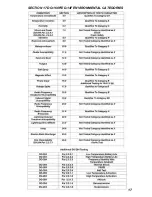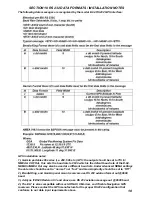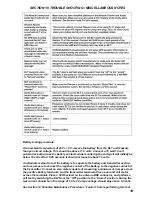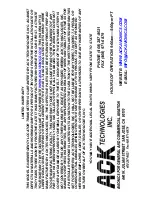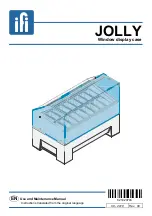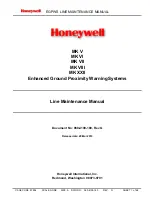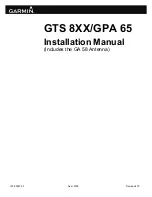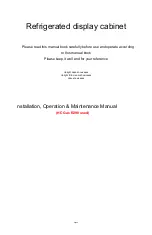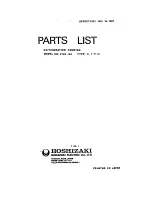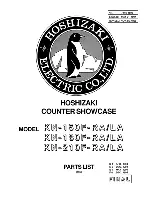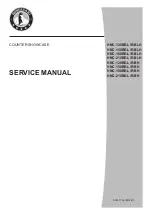
to the connecting cable, and inspect the jack and plug assembly for corrosion.
4.) If a GPS is interfaced to the ELT, inspect the modular cable connecting the ELT to the
GPS unit for signs of wear or abrasion on its outer jacket. Remove the modular plug
connecting the ELT transmitter to the GPS and inspect the jack and plug assembly for
corrosion.
5.) Check the expiration date of the RCPI battery and audio alert battery in the aircraft log
book. Check the expiration date of the battery pack and replace if necessary.
6.) Leave the ELT in the “Armed” position, then remove the ELT from the aircraft, and
perform a G switch test as follows:
This test should be conducted between the hour, and 5 minutes after the hour per FCC
requirements. Tune an aircraft radio, or hand held aircraft radio to 121.5 MHz. The radio
should be in close proximity to the area where you will conduct the test.
TURN THE SQUELCH CONTROL ALL THE WAY DOWN, OR OFF.
You should be hearing
white noise on the radio. If switching the main switch from the “Off” to the “Armed”
position wait at least 15 seconds before performing this test. While in the “Armed”
position, hold the ELT at your waist with the arrow printed on the battery case facing away
from you. Move the ELT rapidly away from your waist. When the ELT reaches the full
extent of your arm, retract it back to your waist as fast as possible. You should hear the
121.5 MHz sweep tone in the radio.
AS SOON AS YOU HEAR THE TONE, IMMEDIATELY
TURN THE MAIN SWITCH ON THE ELT TO THE “OFF” POSITION.
The ELT when activated transmits on 121.5 MHz for approximately 50 seconds before a 406
MHz burst is sent to the satellites. This is a live burst which will immediately notify the
COSPAS/SARSAT system that there is an emergency.
IT IS IMPERATIVE THAT YOU DO
NOT ALLOW AN ACTIVATED ELT, TO TRANSMIT FOR MORE THAN 30 SECONDS DURING
G SWITCH TESTING.
3
7.) Reinstall the ELT, make sure the cables are secured, and properly connected. Make
sure to seal the din connector if the ELT is connected to the aircraft GPS. (Page 8 Fig. 12.5)
Place the main switch in the “Armed” position, and install the rubber cover over the main
switch opening.
3
8.) Perform the self test described in section 9 to verify proper operation.
BATTERY AND ELT DOT/ IATA SHIPPING INFORMATION
The ELT with the battery attached is a DOT/IATA class 9 hazmat material under the
category of life saving appliances not self inflating UN 3072.
THERE ARE NO AIR
SHIPMENT RESTRICTIONS FOR SUCH DEVICES, AND THEY MAY BE SHIPPED IN ANY
QUANTITY IN PASSENGER CARRYING, OR TRANSPORT AIRCRAFT.
The original ACK
ELT shipping box complies with (UN) United Nations packaging specifications.
12
SECTION 11 E-04.0 LITHIUM BATTERY REPLACEMENT
REPLACEMENT OF THE MAIN LITHIUM BATTERY P/N E-04.0
The lithium battery (P/N E-04.0) must be replaced on, or before the battery expiration date
marked on the battery. It is no longer airworthy after this date. See far 91.207 for other ELT
requirements.
1.) Using a 3/32 hex wrench, remove the four retaining screws that attach the battery case
to the ELT transmitter assembly, and gently pull the battery pack from the transmitter
section. (Page 7 Fig. 9)
2.)
WITH THE MAIN SWITCH IN THE “OFF” POSITION,
install the new sealed battery pack.
(P/N E-04.0) The battery pack is designed so the battery can only be installed in the proper
orientation. Wet the O-ring with a mild dish soap solution, and shake off the excess
solution, or use silicon vacuum grease. Install the O-ring onto the battery case. Remove
the two protective caps from the battery contacts. (Page 13 Fig. 18) The battery pack
should slide easily into the transmitter housing.
3.) Re-attach the transmitter assembly to the battery pack by replacing the four hex head
screws. Tighten the screws to 3.5-4.0 in-lbs.
4.) Record the new battery expiration date in the airframe logbook.
5.) After re-installation of the ELT into the aircraft, a self test must be performed. Refer to
section 9.

















